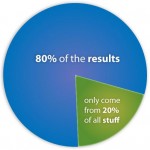 In most situations roughly 80% of effects come from only 20% of the causes. By using the Pareto Principle, we can decide how better manage our time and focus on the things on our task list that really make a difference.
In most situations roughly 80% of effects come from only 20% of the causes. By using the Pareto Principle, we can decide how better manage our time and focus on the things on our task list that really make a difference.
Harvard Business Review notes that practically everything is unimportant. The Pareto Principle has been applied to almost every human endeavour, from software development to investing. (Two examples: 90% of Warren Buffet’s wealth is from just ten investments and, in sales, typically 80% of revenue comes from 20% of the sales team.)
Looking at our own productivity from the lens of this “law of the vital few,” we can cut the 80% of our tasks or projects that are unimportant or don’t contribute to our end goals.
Trouble prioritizing your tasks? Try this:
When you make a “to do” list, prioritize each item by the amount of effort required (1 to 10, with 1 being the least amount of effort) and the potential positive results (1 to 10, with 10 being the highest impact.)
Now divide the potential results by the amount of effort to get a “priority” ranking. Do the items with the lowest resulting priority number first. Here’s a simple example:
- Task 1: Write report on trip meeting.
Effort=10, Result=2, Priority=5 - Task 2: Prepare presentation for marketing.
Effort=4, Result=4, Priority=1 - Task 3: Call current customer about referral.
Effort=1, Result=10, Priority=0.1
See your new priority-based order? You do Task 3 first, Task 2 second, and Task 1 last–if at all.
This way, you ensure you do those important low-effort tasks that make up 80% of your success.
Great idea
Perfect
This doesn’t change the concept, but the math is incorrect. If you divide the potential results by the amount of effort for each the results are .02, 1, and 10. The figures above show the math for dividing the effort by the impact.